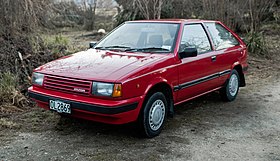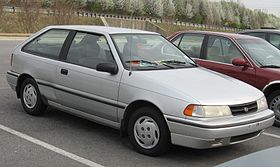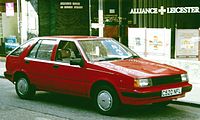Hyundai Excel
| Hyundai Excel | |
|---|---|
 First generation | |
| Overview | |
| Manufacturer | Hyundai |
| Also called | Hyundai Pony Hyundai Pony Excel (X1 hatchback in South Korea) Hyundai Presto (X1 sedan in South Korea) Mitsubishi Precis Hyundai X2 (UK)[1] |
| Production | 1985–2000 |
| Body and chassis | |
| Class | Subcompact car (B) |
| Layout | FF layout |
| Related | Hyundai Scoupe Mitsubishi Mirage |
| Chronology | |
| Predecessor | Hyundai Pony |
| Successor | Hyundai Accent Hyundai Elantra |
The Hyundai Excel (Hangul: 현대 엑셀), also known as the Hyundai Pony, Hyundai Pony Excel, Hyundai Presto, Mitsubishi Precis and Hyundai X2, is an automobile which was produced by Hyundai Motor Company from 1985 to 2000. It was the first front-wheel drive car produced by the South Korean manufacturer. The Excel range replaced the rear wheel drive Hyundai Pony.
Background[edit]
As with the original 1974 Pony, the Excel was designed by Giorgetto Giugiaro. The Excel was available in three- or five-door hatchback and four-door sedan models.[2] The Excel was the first Hyundai car to be exported to the United States.
The Excel was available with either a manual or automatic transmission mated to a four-cylinder engine aspirated by a carburetor or fuel injection system, depending on market and model year.
Originally, the Excel was supposed to be replaced by the Elantra in 1990, but it ended up being sold for four more years until being replaced by the Hyundai Accent in the model year 1995. From 1990, there was a coupé variant called the Hyundai Scoupe, which was replaced by the Hyundai Coupe in 1996.
Names[edit]
Some markets, including Europe, had the Excel branded as the Hyundai Pony, although it is not directly related to its rear wheel drive predecessor of the same name. In South Korea the hatchback version was known as Hyundai Pony Excel, and the sedan version was known as Hyundai Presto.
The Excel was also sold in the United States by Mitsubishi Motors from 1987 to 1994 as the badge engineered Mitsubishi Precis. Available as either a 3- or 5-door hatchback, the Precis remained in the Mitsubishi range as a "price leader," slotted below the Mirage until it was discontinued in 1992.[3]
First Generation (X1; 1985–1989)[edit]
| First generation (X1) | |
|---|---|
 1989 Hyundai Excel GL 3-door (NZ) | |
| Overview | |
| Production | 1985–1989 |
| Assembly | Ulsan, South Korea |
| Designer | Giorgetto Giugiaro at Italdesign |
| Body and chassis | |
| Body style | 3-door hatchback 5-door hatchback 4-door sedan |
| Powertrain | |
| Engine | 1.5 L 68 hp I4 (gasoline) |
| Transmission | 4-speed manual 5-speed manual 3-speed automatic |
| Dimensions | |
| Wheelbase | 93.7 in (2,380 mm) |
| Length | 160.9 in (4,087 mm) (2-door) 168 in (4,267 mm) (4-door) |
| Width | 63.1 in (1,603 mm) |
| Height | 54.1 in (1,374 mm) |
The Excel was introduced as a replacement for the Hyundai Pony. In the United States, it was the company's first and only model (the previous Pony could not be sold in that country as it did not meet federal emissions standards), but thanks to a price of $4,995 USD and being voted 'Best Product #10' by Fortune magazine, it set records for a first-year import by selling 168,882 units, helping push the company's cumulative production past one million by 1986.[4] Similar sales success was replicated in Australia, where it was priced at A$9,990.
Versions available were:
North America
- 1.5 base
- 1.5 GL
- 1.5 GLS (5-door and 4-door only)
- 1.5 GS (3-door only)
Australia
- 1.5 L
- 1.5 GL
- 1.5 GLS
- 1.5 GT
United Kingdom
- 1300 L/Sonnet
- 1300 GLS
- 1500 GL
- 1500 GLS
Second Generation (X2; 1989–1995)[edit]
| Second generation (X2) | |
|---|---|
 | |
| Overview | |
| Also called | Hyundai X2 (UK)[1] |
| Production | 1989–1995 1995–1998 (Philippines) |
| Assembly | Ulsan, South Korea |
| Body and chassis | |
| Body style | 3-door hatchback 5-door hatchback 4-door sedan 3-door panel van[5] |
| Powertrain | |
| Engine | 1.3 L 4G13 I4 1.5 L 81 hp (60 kW) I4 |
| Transmission | 4-speed manual 5-speed manual 3-speed automatic 4-speed automatic |
| Dimensions | |
| Wheelbase | 93.8 in (2,383 mm) |
| Length | 1990–91 & 1993–94 2-Door Hatchback: 161.4 in (4,100 mm) 1990–91 & 1993–94 5-Door Hatchback: 168.3 in (4,275 mm) 1992 Sedan: 168.6 in (4,282 mm) 1992 Hatchback: 161.7 in (4,107 mm) |
| Width | 1990–91 & 1993–94: 63.3 in (1,608 mm) 1992: 63.1 in (1,603 mm) |
| Height | 1993–94: 54.5 in (1,384 mm) 1992: 51.4 in (1,306 mm) 1990: 51.6 in (1,311 mm) |
The second-generation Excel was given a facelift and slightly enlarged from 1990 onwards, while its engine adopted multi-point fuel injection, and a new 4-speed overdrive automatic transmission was offered. It was sold in CX, LX and CXL trim levels in South Korea. The South Korean (home market) range was:
- 1.3 CX (3-door hatchback, 5-door hatchback, 4-door sedan)
- 1.3 LX (3-door hatchback, 5-door hatchback, 4-door sedan)
- 1.5 CX (3-door hatchback, 5-door hatchback, 4-door sedan)
- 1.5 LX (5-door hatchback, 4-door saloon)
- 1.5 CXL (5-door hatchback, 4-door saloon).
The Excel was marketed in Eurasia as the Hyundai Pony or Pony X2 (X2 representing second generation). In the United Kingdom and some parts of Europe, versions available were:
- 1.3 S (3-door hatchback, 5-door hatchback)
- 1.3 Sonnet (3-door hatchback) – replaced 1.3 S base model
- 1.3 LS (3-door hatchback, 5-door hatchback, 4-door sedan)
- 1.5 GSi (5-door hatchback, 4-door sedan)
However, some European markets did not get the 1.3 version and the range was:
- 1.5 L (3-door)
- 1.5 LE (3-door)
- 1.5 GL (3-door hatchback, 5-door hatchback)
- 1.5 LS (3-door hatchback, 5-door hatchback, 4-door sedan)
- 1.5 GS (3-door hatchback, 5-door hatchback, 4-door sedan)
- 1.5 GT (3-door hatchback, 5-door hatchback) – note, not all markets got this version
- 1.5 GLS (3-door hatchback, 5-door hatchback, 4-door sedan)
From 1991, the 1.5 versions were badged 1.5i to denote fuel injection.
All models sold in North America had the 1.5-liter engine producing 81 hp (60 kW) and 91 lb⋅ft (123 N⋅m), with automatic transmission as a freestanding option for any model. The lineup available at U.S. Hyundai dealers was;
- Base (3-door hatchback, 4 door sedan)
- GL (3-door hatchback, 4 door sedan, 5 door hatchback in 1990 only)
- GLS (3-door hatchback, 4 door sedan)
- GS (3-door hatchback)
The 5 door model may have been available in Canada for a longer period and in a wider variety of trims. The Mitsubishi Precis came as a 3-door only, in trim levels equivalent to the base and GL Hyundai-branded cars.
The 1.3 model and the Mitsubishi Colt also share the same engine and gearbox.
Hyundai launched the Excel in Thailand in the early 1990s. The lineup consisted of:
- 1.3 Base (Manual and Automatic)
- 1.3 LS (Manual and Automatic)
- 1.5 LS (Manual)
- 1.5 GLS (Manual and Automatic, with a fuel injected version (GLSi) also available)
Third Generation (X3; 1994–2000)[edit]
When the Hyundai Accent was introduced in 1994 for the 1995 model year, it continued to be called Hyundai Excel in some markets, including the Netherlands, Belgium, and Australia.
References[edit]
| Wikimedia Commons has media related to Hyundai Excel. |
- ^ Jump up to: a b HYUNDAI RANGE 1992-93 UK Mkt sales brochure - HCD-1 Scoupe Lantra X2 Sonata, www.ebay.ie, as archived at web.archive.org
- ^ "Hyundai Excel The Car Directory". The-car-directory.com. 27 December 2007. Archived from the original on 16 July 2011. Retrieved 21 November 2010.
- ^ "ConsumerGuide.com review". Auto.consumerguide.com. 4 October 2006. Archived from the original on 5 September 2008. Retrieved 21 November 2010.
- ^ "Ssay it with SSUVs: Korea's SSangyong goes where the buyers are – sport/utility vehicles", Gwendolyn S. Knapp, Ward's Auto World, April 1996 (FindArticles.com)
- ^ Hyundai EXCEL van 1991 commercial 현대 엑셀 밴, www.youtube.com Retrieved 13 February 2017
| show Hyundai road vehicle timeline, North American market, 1984–present
|
|---|

_(8038131673).jpg)
_Sprint_3-door_hatchback_(2015-11-13)_02.jpg)
_LS_5-door_hatchback_02.jpg)
_LS_sedan_03.jpg)
_LX_sedan_(2010-07-13)_01.jpg)